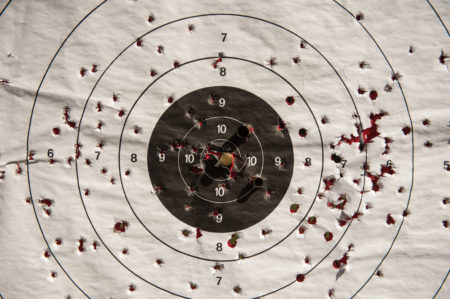There Is No Substitute for Practice

Ever since early man figured out that banging two rocks together can sharpen one of them into a more effective tool, engineers—or what passed for them—have worked tirelessly to build a better proverbial mousetrap. From stone axes to steam engines to Mars rovers, human progress has been defined by advances in technology. Our collective fascination with the latest and greatest becomes especially potent when discussing firearms; the promise of more effective means of self-defense plays to the primal fear of grievous bodily harm. Some of you reading this blog post may have wasted hours of your lives arguing over why X gun is better than Y gun for Z purpose. What is less often considered, but just as important (if not more so), is the importance of the user’s skill.
History abounds with stories of skilled warriors overcoming numerically and technologically superior foes due to their superior training. From the other perspective, those stories are ones of combatants with every measurable advantage losing their lives due to insufficient training. Rudyard Kipling wrote about this unfortunate phenomenon in his 1886 poem “Arithmetic on the Frontier,” inspired by many such cases in the Second Anglo-Afghan War. The British Army during the Anglo-Afghan Wars was one of the most powerful military forces the world had ever seen, backed by a globe-spanning empire. Many of the enemy combatants they encountered were illiterate, impoverished goat herders and subsistence farmers. The “ten-rupee jezail” Kipling references is a muzzle-loading musket made individually by local craftsmen and passed down through the generations. Despite their first-rate military with its superior numbers and cutting-edge technology, the British fought three bitter wars in Afghanistan over the course of eight decades and eventually lost their hold. The what enabled the locals to push the British out was their ability to overcome manpower and firepower with brainpower. Each Afghani fighting man had spent a lifetime adapting to the harsh environment and training with his ancestral musket, to the point that it became second nature for him to achieve a first-round hit on a moving target several hundred yards away without the aid of magnified optics, spitzer bullets, or even smokeless powder.
Although none of you will ever march on Kabul under the Viceroy of British India, the same lessons apply to those of us who keep firearms for concealed carry and home defense. If you get into a defensive situation and take a bullet, you don’t get another try just because your assailant used a bright pink Taurus PT111. As much as there is to learn about firearms, buying the right one is the easiest part of being a gun owner. The hard part is making the time to go to the range and practice on a regular schedule. Practice involves more than just making holes in a stationary bullseye at 7 yards, too—you need to practice every function and manipulation involved in keeping your gun of choice in the fight. That includes drawing from concealment, malfunction drills, reloading in different situations, shooting while moving, and much more.
I’m far from being an expert shot, and I’ll be the first to admit that, but I make a serious effort to maintain proficiency with my defensive firearms. I happen to live in an area with a serious lack of good shooting ranges, so when I don’t have the time to drive to the next county to shoot, I help keep my skills up with forms of practice that I can do at home. Snap caps are great for training reloads and malfunction drills, and they can help with dry-fire practice with some firearms. Dry-firing can improve your trigger control and train out bad habits from the comfort of your own home, ammunition and range fees not required. Even if you don’t have snap caps, you can still at least practice quickly drawing and safely re-holstering your concealed carry handgun. When you are out on the range, make an effort to, as the popular saying goes, “train how you fight.” If your range allows it, you can improve your live-fire training by drawing from a holster or bringing up your long gun from a low ready. Even if they don’t, you may be allowed to fire controlled pairs and transition between targets at different distances. Some of the fancier indoor ranges I’ve seen even have computers that move your target stands around to give you practice shooting at a moving target. I know there are many other great training tips you can get from a certified instructor.
I’ll offer a parting thought on the topic of training for those of you who have limited resources at your disposal. Even if the only firearm at your disposal is nearing obsolescence, it can still be a viable tool for self-defense. That inherited Smith & Wesson Model 10 or Colt M1911 may seem antiquated in comparison to modern “wondernines,” but as long as it runs reliably and hits where you aim it, never feel bad that you can’t afford to replace it with something better. Any gun is better than no gun when lives are on the line, so if something from 50 years ago is all you have, then you might as well get good with it.
